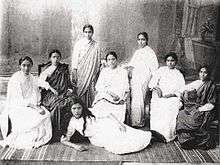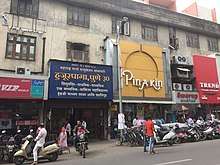Huzurpaga
History

The school was established by the Maharashtra Girls Education Society (MGE) in 1885.[1] The school's founders included noted social reformers Vaman Abaji Modak, Justice Ranade and historian Dr. R. G. Bhandarkar.[2][3] The subjects taught in the school from founding were English literature, arithmetics and science.[4] The establishment of the school and its curriculum were vehemently opposed by Lokmanya Tilak in his newspapers, the Mahratta and Kesari.[5][6]
In 1887, the ruler of the Princely state of Sangli, Tatyasaheb Patwardhan, offered land on Laxmi road in Pune, where the high school is based. The girls' hostel and the elementary school were established later on the same campus.
The school has offered a boarding option for out-of-town students for more than a century. The school and the boarding option were popular among the Bene Israel community in the early part of the 20th century.[7][8] Notable boarders of school include Anandibai Karve and actress Reema Lagu.
In the 1990s, MGE started a new branch of the school in the Pune suburb of Katraj. It started with pre-school and gradually extended to include high school and Higher secondary school respectively.
Academics

The school is officially called the HHCP Girls High School in honor of Tatyasaheb Patwardhan's father, the Maharaja, His Highness Chintamanrao Patwardhan of Sangli. Huzurpaga is located in the main commercial area of Laxmi Road in Pune. The school location was historically used as horse stables for the Maratha Cavalry during the days of Peshwa rule. The school opened its second branch at Katraj. In 2001, the MGE Society established a senior college of commerce exclusively for girls called Huzurpaga Mahila Vanijya Mahavidyalaya (HMVM).[9]
At present, the school offers instruction from grades 5 to 10 to nearly 2,400 girls. The school's medium of instruction is mainly Marathi with some students being offered the chance to learn science and maths through the English language. The latter option is called semi-English curriculum. In the S.S.C. exams conducted by the Maharashtra government for 10th grade students, the school consistently achieves a pass rate in the high 90s percentage.
Notable alumni
- Anandibai Karve (1866 -1950) - Was a boarder with her son in 1890s after her second marriage to social reformer Maharshi Karve and birth of their son [10][11]
- Kashibai Herlekar (1874 -1936) - Social reformer, educationalist and writer[12][13]
- Rebecca Reuben (1889 - 1957) - Bene Israel educationalist - Miss Reuben also taught at the school for three years.[14]
- Padmabhushan Tarabai Modak (1892 -1973) - Advocate of Montessori education [15]
- Muktabai Dixit (1901 - 1980) - Writer in Marathi
- Irawati Karve (1905 – 11 August 1970) - Eminent social scientist & anthropologist
- Malati Bedekar (née Baltai Khare) - Writer in Marathi
- Kamal Ranadive (8 November 1917 – 2001) - Biologist specializing in cancer research
- Shanta Shelke (19 October 1922 – 6 June 2002) - Poet and writer in Marathi language
- Shirish Pai (1929-) - Writer in Marathi and English
- Sai Paranjpye (1938-) - Broadcaster and film director
- Rohini Godbole (1952-) - Particle physicist
- Reema Lagoo (1958- 2017) - Stage and film actress[16]
- Mrunal Kulkarni (1971-) - Actress
- Tejashree Walavalkar - Actress. she played young Ramabai Ranade in the Marathi TV serial, Unch Maaza Zoka.[17]
- Prajakta Gaikwad (1998-) - Actress. She has worked in the Marathi TV serial Swarajyarakshak Sambhaji as Maharani Yesubai, the wife of Chatrapati Sambhaji Maharaj.[18]
References
- Ghurye, G. S. (1954). Social Change in Maharashtra, II. Sociological Bulletin, page 51.
- Bhattacharya, edited by Sabyasachi (2002). Education and the disprivileged : nineteenth and twentieth century India (1. publ. ed.). Hyderabad: Orient Longman. p. 239. ISBN 978-8125021926. Retrieved 12 September 2016.CS1 maint: extra text: authors list (link)
- "Huzurpaga". Huzurpaga.
- Bhattacharya, edited by Sabyasachi (2002). Education and the disprivileged : nineteenth and twentieth century India (1. publ. ed.). Hyderabad: Orient Longman. p. 240. ISBN 978-8125021926. Retrieved 12 September 2016.CS1 maint: extra text: authors list (link)
- Rao, P.V., 2008. Women's Education and the Nationalist Response in Western India: Part II–Higher Education. Indian Journal of Gender Studies, 15(1), pp.141-148.
- Rao, P.V., 2007. Women's Education and the Nationalist Response in Western India: Part I-Basic Education. Indian Journal of Gender Studies, 14(2), p.307.
- Feinberg, Miriam P.; Shapiro, Miriam Klein (2010). Hear Her Voice! Twelve Jewish Women Who Changed the World (First ed.). Pitspopany Press. ISBN 978-1936068029. Retrieved 6 November 2016.
- Roland, Joan G. (1998). The Jewish communities of India : identity in a colonial era (2. ed.). New Brunswick [u.a.]: Transaction Publ. p. 318. ISBN 978-0765804396. Retrieved 6 November 2016.
- Mahila Vanijya Mahavidyalaya (HMVM)
- Kosambi, Meera edited by (2000). Intersections : socio-cultural trends in Maharashtra. New Delhi: Orient Longman. p. 109. ISBN 978-8125018780. Retrieved 11 November 2016.
- Ellen E. McDonald (1963). The New Brahmans: Five Maharashtrian Families. University of California Press. p. 74. GGKEY:U3PU2CLAUDR.
- Anagol, Padma (2006). The emergence of feminism in India, 1850-1920. Aldershot: Ashgate. p. 231. ISBN 978-0754634119. Retrieved 11 November 2016.
- Das, Sisir Kumar (1991). A history of Indian literature, 1800-1910 : western impact: Indian response (Reprint. ed.). New Delhi: Sahitya Akademi. p. 250. ISBN 978-8172010065.
- Feinberg, Miriam P.; Shapiro, Miriam Klein (2010). Hear Her Voice! Twelve Jewish Women Who Changed the World (First ed.). Pitspopany Press. ISBN 978-1936068029. Retrieved 6 November 2016.
- Srivastava, Gouri (2000). Women's higher education in the 19th century. New Delhi: Concept Pub. Co. p. 190. ISBN 9788170228233. Retrieved 20 December 2016.
- "फोटो आणि रिमा लागूंची पुण्यातली एक आठवण" (in Marathi). Zee News. 18 May 2017. Retrieved 18 May 2017.
ज्येष्ठ अभिनेत्री रिमा लागू १९७० ते १९७४ या कालावधीत हुजुरपागा शाळेत शिकत होत्या
- "In full swing". Pune Mirror (July 29, 2012). BENNETT, COLEMAN & CO. LTD. 2012. Retrieved 1 June 2020.
- "Prajakta Gaikwad a warrior queen in reel and real life". Punekar News (November 11, 2019).